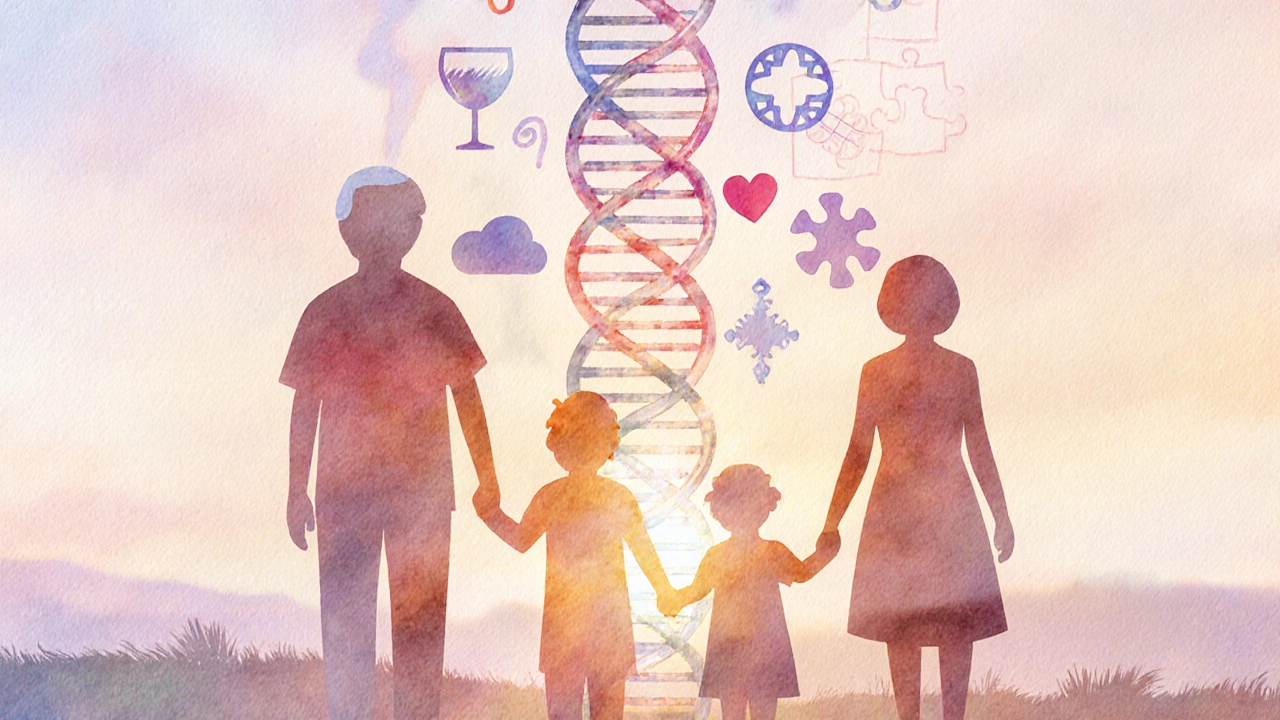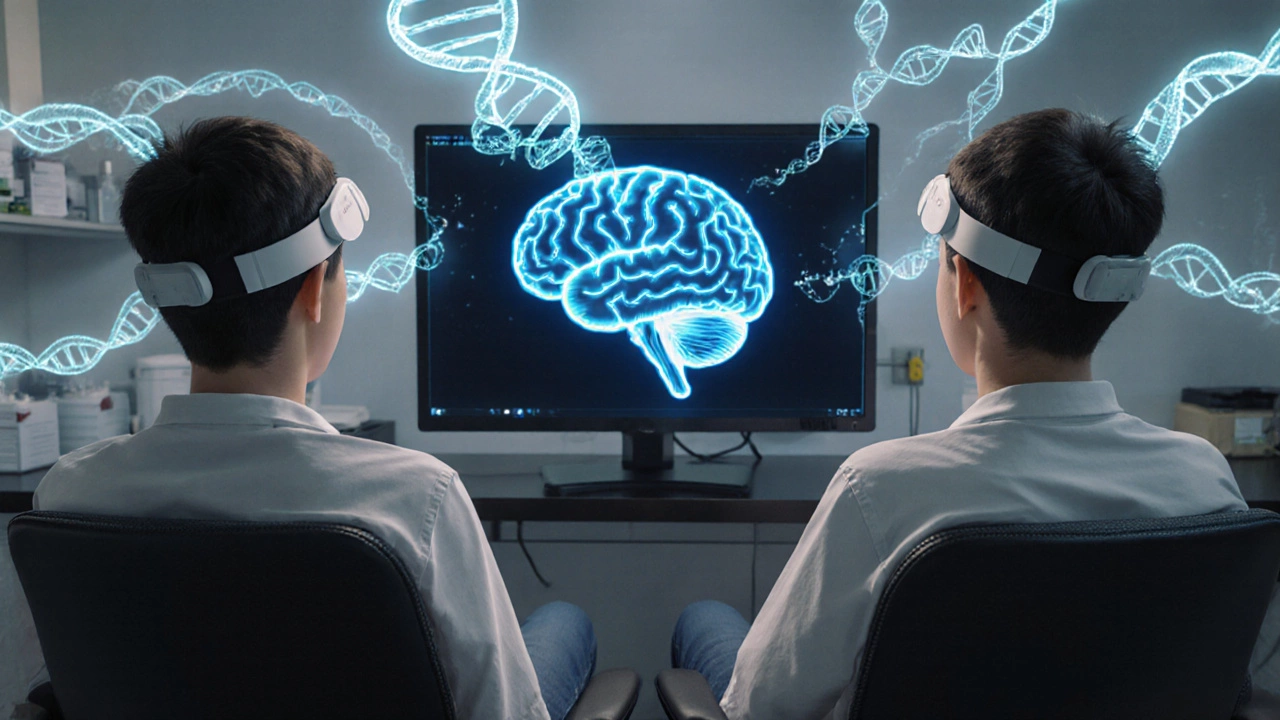Genetic Mental Illnesses: Which Disorders Are Hereditary?
 Oct, 12 2025
Oct, 12 2025
Genetic Risk Calculator
This calculator estimates your genetic risk for mental health disorders based on family history. Remember: genetics is only one factor in mental health risk, and environmental factors play a significant role.
Note: This tool is for informational purposes only and does not replace professional medical advice.
Genetic mental illness is a mental health condition whose risk is significantly influenced by inherited genetic factors. If you’ve ever wondered whether anxiety, depression, or other disorders run in families, you’re not alone. Below you’ll discover which mental illnesses have the strongest genetic backing, how scientists measure that risk, and what it means for you and your loved ones.
Key Takeaways
- Schizophrenia, bipolar disorder, major depressive disorder, autism spectrum disorder, ADHD, OCD, and anorexia nervosa all show clear genetic influence.
- Heritability estimates range from about 30% (depression) to over 80% (schizophrenia).
- Twin and family studies, plus modern genome‑wide association studies (GWAS), are the main tools for untangling genetics from environment.
- Having a family history raises risk, but it’s never a guarantee; lifestyle, trauma, and support matter a lot.
- If you’re concerned, talk to a mental‑health professional about screening, early signs, and preventive strategies.
How Genetics Meets Mental Health
Genes are tiny packets of instruction that tell cells how to work. When a gene mutates or varies, it can shift brain chemistry, neural development, or stress response - all of which can tip the balance toward a mental health condition. However, mental illnesses are “complex” traits: dozens to hundreds of genes each add a small push, and the environment can amplify or dampen those pushes.
Scientists usually express genetic impact as a **heritability percentage** - the proportion of variation in a population that can be traced to genetic differences. A heritability of 60% for a disorder doesn’t mean 60% of an individual’s risk is genetic; it simply tells us that, on average, genetics explains most of the differences we see across people.
Disorders With Strong Genetic Links
Below is a rundown of the most studied mental illnesses that show measurable hereditary patterns.
- Schizophrenia is a chronic disorder marked by hallucinations, delusions, and disorganized thinking. Twin studies put its heritability around 80%.
- Bipolar disorder features extreme mood swings from mania to depression. Heritability estimates hover between 70% and 85%.
- Major depressive disorder (MDD) is characterized by persistent low mood and loss of interest. Genetics accounts for roughly 30%-40% of the risk.
- Autism spectrum disorder (ASD) involves challenges with social interaction and repetitive behaviors. Heritability is high - about 70%-90%.
- Attention‑deficit/hyperactivity disorder (ADHD) shows up as inattention, impulsivity, and hyperactivity. Studies suggest 70%-80% heritability.
- Obsessive‑compulsive disorder (OCD) is marked by intrusive thoughts and repetitive rituals. Heritability sits near 50%-60%.
- Anorexia nervosa is an eating disorder defined by extreme restriction of food intake. Recent GWAS point to a heritability of about 50%.

Comparing Heritability Across Disorders
| Disorder | Heritability (%) | Notable Genes / Variants | Typical Onset Age |
|---|---|---|---|
| Schizophrenia | 80 | COMT, DRD2, C4 | Late teens-early 20s |
| Bipolar disorder | 75 | ANK3, CACNA1C | Early 20s |
| Major depressive disorder | 35 | 5‑HTTLPR, SIRT1 | Varies (often 20s-40s) |
| Autism spectrum disorder | 85 | CHD8, SHANK3, CNTNAP2 | Before age 3 |
| ADHD | 75 | DRD4, DAT1 (SLC6A3) | Childhood |
| OCD | 55 | SLC1A1, 5‑HT2A | Late childhood-early teens |
| Anorexia nervosa | 50 | EDNRB, ESR2 | Adolescence |
How Scientists Pinpoint Genetic Influence
The gold standard for measuring heritability is the twin study. By comparing identical twins (who share 100% of their DNA) with fraternal twins (about 50% shared), researchers can estimate how much of a disorder’s variance is genetic. Large‑scale family registries, especially in Scandinavian countries, add another layer by tracking risk across generations.
In the last decade, genome‑wide association studies (GWAS) have exploded. These studies scan millions of DNA markers in thousands of patients to spot common variants that appear more often in people with a particular disorder. While each variant usually shifts risk by only a few percent, the cumulative effect-the polygenic risk score-can help identify individuals at higher genetic susceptibility.
Even with powerful tools, genetics never tells the whole story. Epigenetic changes (chemical tags that turn genes on or off) can be triggered by stress, nutrition, or trauma, reshaping the risk landscape without altering the DNA sequence itself.
Genes vs. Environment: The Real‑World Mix
Imagine two siblings: both inherit a set of risk genes for depression, but only one experiences a major loss or chronic stress. The stressed sibling is far more likely to develop depression, showing how environment can tip the scales. This “gene‑environment interaction” is why many people with high genetic risk never develop a disorder, while others with low genetic risk do.
Key environmental factors that amplify genetic vulnerability include:
- Early childhood trauma or neglect.
- Substance misuse, especially during adolescence.
- Chronic sleep deprivation or poor nutrition.
- Social isolation and chronic stress.
Conversely, protective factors-strong social support, regular physical activity, and early therapeutic interventions-can lower the odds, even for those with a strong family history.

What to Do If You Have a Family History
- Talk to a professional. A psychiatrist or psychologist can assess your personal risk, look for early warning signs, and suggest monitoring plans.
- Consider genetic counseling. While routine genetic testing for most mental illnesses isn’t standard practice yet, counselors can explain what existing data mean for you.
- Track mood and behavior changes. Simple apps or a journal can help you spot patterns before they become severe.
- Build a support network. Friends, family, or peer groups provide buffers against stress.
- Adopt lifestyle habits that protect brain health: regular exercise, balanced diet, adequate sleep, and stress‑reduction techniques like mindfulness.
Remember, genetics is a piece of the puzzle, not a life sentence. Early awareness and proactive care often make a huge difference.
Frequently Asked Questions
Frequently Asked Questions
Can I get a DNA test to know if I’ll develop a mental illness?
Most commercial DNA tests today focus on single‑gene traits and do not provide reliable predictions for complex mental illnesses. Researchers are working on polygenic risk scores, but they’re still mainly a research tool. The best approach is to discuss family history with a mental‑health professional.
If my parent has schizophrenia, does that mean I will too?
No. Even with a 80% heritability, the absolute risk for a child of a parent with schizophrenia is roughly 10%-15%, far higher than the 1%‑2% population risk but far from certain. Environmental factors, early intervention, and lifestyle choices all influence the outcome.
Do identical twins always share the same mental illness?
Not always. Identical twins share the same DNA, but concordance rates for disorders like depression or anxiety are usually below 50%. This shows that non‑genetic factors play a big role.
Can lifestyle changes offset a high genetic risk?
Yes, to a considerable extent. Regular exercise, good sleep hygiene, stress management, and strong social connections have all been linked to lower incidence and milder symptoms, even in people with high polygenic risk scores.
Are there medications that target the genetic causes of mental illness?
Most current medications address neurotransmitter imbalances rather than the underlying genes. However, research into “gene‑based” therapies-like CRISPR or RNA‑interference-is ongoing, though no such treatments are approved for common mental illnesses yet.
Understanding which mental illnesses are genetic equips you to ask the right questions, seek early help, and make lifestyle choices that can tip the odds in your favor. Genetics sets the stage, but you still get to write most of the script.